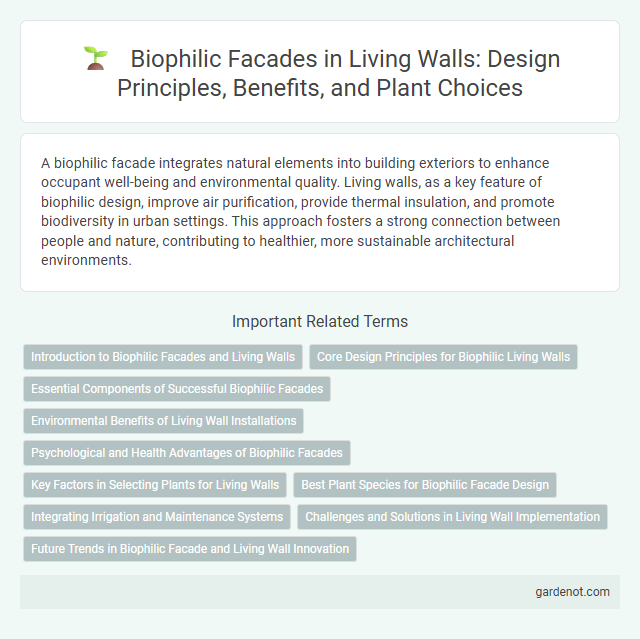A biophilic facade integrates natural elements into building exteriors to enhance occupant well-being and environmental quality. Living walls, as a key feature of biophilic design, improve air purification, provide thermal insulation, and promote biodiversity in urban settings. This approach fosters a strong connection between people and nature, contributing to healthier, more sustainable architectural environments.
Introduction to Biophilic Facades and Living Walls
Biophilic facades integrate natural elements like living walls into building exteriors, enhancing urban environments with greenery that improves air quality and promotes well-being. Living walls consist of vertically arranged plants and vegetation systems that support biodiversity and provide thermal insulation, contributing to energy efficiency. These installations embody biophilic design principles by reconnecting occupants with nature, reducing stress, and fostering healthier indoor-outdoor relationships.
Core Design Principles for Biophilic Living Walls
Core design principles for biophilic living walls emphasize integrating natural patterns, textures, and colors to enhance occupant well-being and environmental connection. Selecting diverse native plant species promotes biodiversity and resilience while optimizing air quality and thermal regulation. Strategic placement of plants maximizes sunlight exposure and supports ecological processes, reinforcing the facade's role as a dynamic, living ecosystem.
Essential Components of Successful Biophilic Facades
Essential components of successful biophilic facades include the integration of natural vegetation, use of permeable substrates for plant growth, and effective irrigation systems to maintain plant health. Incorporating diverse plant species enhances biodiversity and aesthetic appeal, while structural materials must support both plant load and environmental factors such as wind and rain. Smart monitoring technologies help optimize water usage and plant vitality, ensuring long-term sustainability and improved building performance.
Environmental Benefits of Living Wall Installations
Living wall installations significantly improve urban air quality by filtering pollutants and increasing oxygen levels through their dense plant coverage. These biophilic facades reduce building energy consumption by providing natural insulation, which lowers heating and cooling costs while mitigating the urban heat island effect. Moreover, living walls enhance biodiversity by creating microhabitats that support pollinators and other beneficial wildlife within city environments.
Psychological and Health Advantages of Biophilic Facades
Biophilic facades integrate natural elements into building exteriors, significantly enhancing psychological well-being by reducing stress and improving mood. Exposure to greenery through these living walls promotes cognitive function and mental clarity, fostering a stronger connection to nature. Studies indicate that occupants of buildings with biophilic facades experience lower levels of anxiety and increased overall health benefits, including improved air quality and reduced urban heat effects.
Key Factors in Selecting Plants for Living Walls
Selecting plants for a biophilic facade requires prioritizing species with high adaptability to local climate conditions, ensuring resilience and year-round greenery. Plants with efficient water usage and low maintenance needs reduce resource consumption and upkeep costs, enhancing sustainability. Incorporating native plants and those with air-purifying properties improves biodiversity and indoor air quality, aligning with biophilic design principles.
Best Plant Species for Biophilic Facade Design
Ficus pumila and Hedera helix are among the best plant species for biophilic facade design due to their vigorous growth and ability to create dense green coverage. Succulents like Sedum and Sempervivum are ideal for low-maintenance living walls, providing drought tolerance and diverse textures. Ferns such as Nephrolepis exaltata contribute to enhanced air quality and aesthetic appeal, making them perfect for shaded or indoor facades.
Integrating Irrigation and Maintenance Systems
Integrating irrigation and maintenance systems in biophilic facades ensures optimal water delivery and prolongs plant health on living walls. Advanced drip irrigation coupled with automated sensors monitors moisture levels, reducing water waste and promoting sustainable growth. Regular maintenance protocols, facilitated by easy-access designs, support plant vitality and extend the lifespan of green facades.
Challenges and Solutions in Living Wall Implementation
Biophilic facades, such as living walls, face challenges including structural load management, irrigation system complexity, and plant species selection to ensure durability and sustainability. Solutions involve integrating lightweight modular panels, automated drip irrigation with moisture sensors, and selecting native, drought-resistant plants to optimize water use and resilience. Advanced monitoring systems and regular maintenance protocols further address microclimate variations and plant health for long-term performance.
Future Trends in Biophilic Facade and Living Wall Innovation
Emerging technologies in biophilic facades integrate advanced sensor systems and adaptive plant species to enhance environmental responsiveness and energy efficiency. Innovations in modular living wall designs facilitate easier installation, maintenance, and biodiversity enhancement, supporting urban ecosystem resilience. Future trends emphasize smart irrigation, AI-driven plant health monitoring, and incorporation of air-purifying species to optimize indoor air quality and occupant well-being.
Biophilic facade Infographic

 gardenot.com
gardenot.com